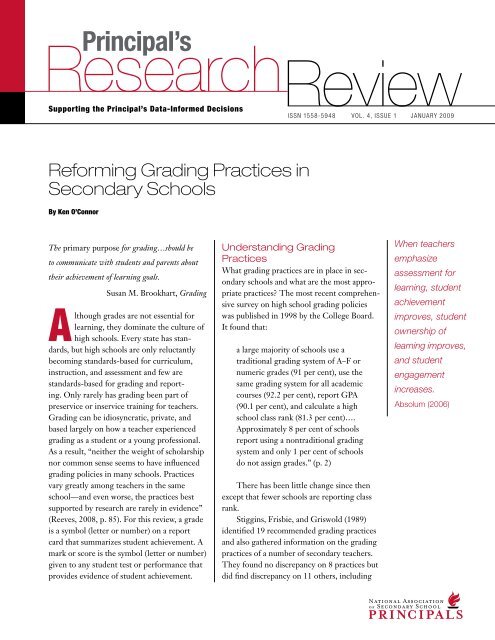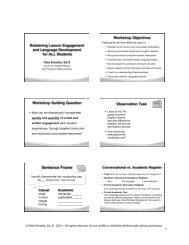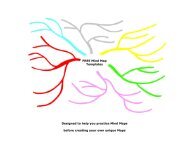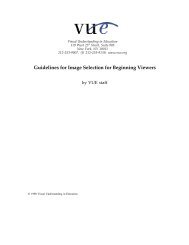Reforming Grading Practices in Secondary Schools - eStaffRoom
Reforming Grading Practices in Secondary Schools - eStaffRoom
Reforming Grading Practices in Secondary Schools - eStaffRoom
Create successful ePaper yourself
Turn your PDF publications into a flip-book with our unique Google optimized e-Paper software.
Pr<strong>in</strong>cipal’s<br />
ResearchReview<br />
Support<strong>in</strong>g the Pr<strong>in</strong>cipal’s Data-Informed Decisions<br />
issn 1558-5948 Vol. 4, Issue 1 january 2009<br />
<strong>Reform<strong>in</strong>g</strong> <strong>Grad<strong>in</strong>g</strong> <strong>Practices</strong> <strong>in</strong><br />
<strong>Secondary</strong> <strong>Schools</strong><br />
By Ken O’Connor<br />
The primary purpose for grad<strong>in</strong>g…should be<br />
to communicate with students and parents about<br />
their achievement of learn<strong>in</strong>g goals.<br />
Susan M. Brookhart, <strong>Grad<strong>in</strong>g</strong><br />
Although grades are not essential for<br />
learn<strong>in</strong>g, they dom<strong>in</strong>ate the culture of<br />
high schools. Every state has standards,<br />
but high schools are only reluctantly<br />
becom<strong>in</strong>g standards-based for curriculum,<br />
<strong>in</strong>struction, and assessment and few are<br />
standards-based for grad<strong>in</strong>g and report<strong>in</strong>g.<br />
Only rarely has grad<strong>in</strong>g been part of<br />
preservice or <strong>in</strong>service tra<strong>in</strong><strong>in</strong>g for teachers.<br />
<strong>Grad<strong>in</strong>g</strong> can be idiosyncratic, private, and<br />
based largely on how a teacher experienced<br />
grad<strong>in</strong>g as a student or a young professional.<br />
As a result, “neither the weight of scholarship<br />
nor common sense seems to have <strong>in</strong>fluenced<br />
grad<strong>in</strong>g policies <strong>in</strong> many schools. <strong>Practices</strong><br />
vary greatly among teachers <strong>in</strong> the same<br />
school—and even worse, the practices best<br />
supported by research are rarely <strong>in</strong> evidence”<br />
(Reeves, 2008, p. 85). For this review, a grade<br />
is a symbol (letter or number) on a report<br />
card that summarizes student achievement. A<br />
mark or score is the symbol (letter or number)<br />
given to any student test or performance that<br />
provides evidence of student achievement.<br />
Understand<strong>in</strong>g <strong>Grad<strong>in</strong>g</strong><br />
<strong>Practices</strong><br />
What grad<strong>in</strong>g practices are <strong>in</strong> place <strong>in</strong> secondary<br />
schools and what are the most appropriate<br />
practices? The most recent comprehensive<br />
survey on high school grad<strong>in</strong>g policies<br />
was published <strong>in</strong> 1998 by the College Board.<br />
It found that:<br />
a large majority of schools use a<br />
traditional grad<strong>in</strong>g system of A–F or<br />
numeric grades (91 per cent), use the<br />
same grad<strong>in</strong>g system for all academic<br />
courses (92.2 per cent), report GPA<br />
(90.1 per cent), and calculate a high<br />
school class rank (81.3 per cent)….<br />
Approximately 8 per cent of schools<br />
report us<strong>in</strong>g a nontraditional grad<strong>in</strong>g<br />
system and only 1 per cent of schools<br />
do not assign grades.” (p. 2)<br />
There has been little change s<strong>in</strong>ce then<br />
except that fewer schools are report<strong>in</strong>g class<br />
rank.<br />
Stigg<strong>in</strong>s, Frisbie, and Griswold (1989)<br />
identified 19 recommended grad<strong>in</strong>g practices<br />
and also gathered <strong>in</strong>formation on the grad<strong>in</strong>g<br />
practices of a number of secondary teachers.<br />
They found no discrepancy on 8 practices but<br />
did f<strong>in</strong>d discrepancy on 11 others, <strong>in</strong>clud<strong>in</strong>g<br />
When teachers<br />
emphasize<br />
assessment for<br />
learn<strong>in</strong>g, student<br />
achievement<br />
improves, student<br />
ownership of<br />
learn<strong>in</strong>g improves,<br />
and student<br />
engagement<br />
<strong>in</strong>creases.<br />
Absolum (2006)
ecommendations that achievement should be the<br />
sole <strong>in</strong>gredient <strong>in</strong> grades, that attitudes should not<br />
be <strong>in</strong>cluded as a grad<strong>in</strong>g variable, and that consistent<br />
policies should be followed. (See figure 1.) Stigg<strong>in</strong>s<br />
et al. (1989) suggested three possible reasons for<br />
the discrepancies: that best practice is a matter of<br />
op<strong>in</strong>ion, that measurement specialists fail to take <strong>in</strong>to<br />
account the practical realities of the classroom, and<br />
that teachers are unaware of the recommendations. A<br />
consensus has s<strong>in</strong>ce emerged as to what is best practice,<br />
and a number of researchers and practitioners<br />
have recommended guidel<strong>in</strong>es for grad<strong>in</strong>g (e.g., Guskey<br />
& Bailey, 2001; Toml<strong>in</strong>son & McTighe, 2006;<br />
Marzano, 2000, 2006; Stigg<strong>in</strong>s, Arter, Chappius, and<br />
Chappius, 2004; Wormeli, 2006; Cooper, 2007; and<br />
O’Connor, 2002, 2007). There are differences <strong>in</strong> order,<br />
emphasis, and words <strong>in</strong> the guidel<strong>in</strong>es, but these<br />
educators have many years of teach<strong>in</strong>g experience<br />
and make similar recommendations.<br />
Some researchers, such as Kohn (1994), called<br />
for abandon<strong>in</strong>g grades completely. He suggested that<br />
grades lead to less successful learn<strong>in</strong>g, less <strong>in</strong>terest <strong>in</strong><br />
learn<strong>in</strong>g, and less will<strong>in</strong>gness to engage <strong>in</strong> challeng<strong>in</strong>g<br />
tasks. However, Clymer and Wiliam (2006/07)<br />
disagreed. They stated that if teachers do not provide<br />
some <strong>in</strong>dication of students’ achievement, school systems<br />
are likely to rely on timed written exam<strong>in</strong>ations.<br />
They also found that appropriately designed grad<strong>in</strong>g<br />
systems can help identify where students are <strong>in</strong> their<br />
understand<strong>in</strong>g and what they need to improve.<br />
It is essential to be clear about the primary purpose<br />
of grades, which is to communicate students’<br />
achievement of learn<strong>in</strong>g goals. As Brookhart (2004)<br />
noted, grades have a secondary purpose that <strong>in</strong>cludes<br />
provid<strong>in</strong>g teachers with <strong>in</strong>formation for <strong>in</strong>structional<br />
plann<strong>in</strong>g and provid<strong>in</strong>g teachers, adm<strong>in</strong>istrators,<br />
parents, and students with <strong>in</strong>formation for placement<br />
of students. She also noted that the ma<strong>in</strong> difficulty<br />
driv<strong>in</strong>g grad<strong>in</strong>g issues is that grades serve a variety<br />
of conflict<strong>in</strong>g purposes. Bailey and McTighe (1996)<br />
agreed that the primary purpose of grades is to communicate<br />
student achievement to students, parents,<br />
school adm<strong>in</strong>istrators, postsecondary <strong>in</strong>stitutions,<br />
and employers.<br />
Figure 1.<br />
Recommended <strong>Grad<strong>in</strong>g</strong> <strong>Practices</strong><br />
Discrepancy<br />
n Achievement as only characteristic <strong>in</strong> grades<br />
n Ability not <strong>in</strong>cluded <strong>in</strong> grades<br />
n Motivation and effort <strong>in</strong>cluded <strong>in</strong> grades<br />
n All daily assignments <strong>in</strong>cluded <strong>in</strong> grades<br />
n Amount of grad<strong>in</strong>g data gathered<br />
n Quality of grad<strong>in</strong>g data<br />
n Consistent policies followed<br />
n Methods of aggregat<strong>in</strong>g components<br />
n Fixed percentages as cutoff scores<br />
n Total po<strong>in</strong>t accumulation for cutoff scores<br />
n Decid<strong>in</strong>g on borderl<strong>in</strong>e cases<br />
No Discrepancy<br />
n Communicat<strong>in</strong>g grad<strong>in</strong>g methods to students<br />
n Attitude not <strong>in</strong> grades<br />
n Interest not <strong>in</strong> grades<br />
n Personality not <strong>in</strong> grades<br />
n Written tests <strong>in</strong> grades<br />
n Oral question<strong>in</strong>g dur<strong>in</strong>g <strong>in</strong>struction not <strong>in</strong> grades<br />
n Performance assessments <strong>in</strong> grades<br />
n Normal distribution not used<br />
Stigg<strong>in</strong>s, Frisbie, and Griswold (1989, pp. 7–8)<br />
2<br />
Pr<strong>in</strong>cipal’s ResearchReview january 2009
Major Issues of <strong>Grad<strong>in</strong>g</strong><br />
<strong>Grad<strong>in</strong>g</strong> Variables<br />
Most teachers have comb<strong>in</strong>ed achievement with<br />
behavior to vary<strong>in</strong>g extents <strong>in</strong> determ<strong>in</strong><strong>in</strong>g grades<br />
because they believe it demonstrates what they value<br />
and will motivate students to exhibit those behaviors.<br />
McMillan (2001) noted that “the f<strong>in</strong>d<strong>in</strong>gs from this<br />
study, along with other results from other studies,<br />
show that this practice is still pervasive” (p. 30).<br />
Gathercoal (2004) noted that “due to the excessive<br />
entanglement between achievement and behavior,<br />
achievement grades are often mis<strong>in</strong>terpreted” (p. 153).<br />
Tony W<strong>in</strong>ger, a high school teacher <strong>in</strong> Littleton,<br />
CO, (2005) said:<br />
I recall tell<strong>in</strong>g my students, “Work hard<br />
and your grade will be f<strong>in</strong>e.” Although I did<br />
not realize it, the message to my students<br />
was clear: My unconscious message to my<br />
students was one of compliance…. Some<br />
students received good grades and learned<br />
little, others learned much and failed (p. 62).<br />
Reeves (2008) concluded, “When schools<br />
improve grad<strong>in</strong>g policies—for example, by disconnect<strong>in</strong>g<br />
grades from behavior—student achievement<br />
<strong>in</strong>creases and behavior improves dramatically” (p. 90).<br />
Accord<strong>in</strong>g to Guskey (2009), the criteria for<br />
grades can be grouped <strong>in</strong>to three broad categories:<br />
product, process, and progress.” Product criteria is<br />
concerned with what students know and are able<br />
to do at a particular po<strong>in</strong>t <strong>in</strong> time. Process criteria<br />
looks at how students got there, which <strong>in</strong>cludes work<br />
habits, homework, punctuality of assignments, and<br />
class participation. Progress criteria focus on what<br />
students ga<strong>in</strong>ed from their learn<strong>in</strong>g experiences.<br />
Guskey found that most teachers base their grad<strong>in</strong>g<br />
procedures on a comb<strong>in</strong>ation of all three types<br />
of criteria. He also noted that most researchers and<br />
measurement specialists recommend the exclusive<br />
use of product criteria <strong>in</strong> determ<strong>in</strong><strong>in</strong>g students’<br />
grades. Given the concerns that lead to these differences,<br />
Guskey recommended a solution used by “<strong>in</strong>creas<strong>in</strong>g<br />
numbers of students and schools…to report<br />
separate grades or marks for students on each set of<br />
criteria” (p. 20). This requires the use of expanded<br />
report cards that provide a grade for achievement<br />
only (product), specific <strong>in</strong>formation on learn<strong>in</strong>g skills<br />
(process), and sufficient space for teachers to be able<br />
to comment on growth (progress).<br />
Guskey and Bailey (2001) identified typical<br />
sources of grad<strong>in</strong>g and report<strong>in</strong>g evidence: exams or<br />
compositions, quizzes, reports or projects, student<br />
portfolios, oral presentations, homework, class<br />
participation, laboratory projects, student notebooks<br />
or journals, and punctuality of assignments. Other<br />
grad<strong>in</strong>g sources <strong>in</strong>clude effort, attendance, behavior,<br />
and progress made.<br />
Purpose of Assessment<br />
Welsh and D’Agost<strong>in</strong>o (2009) stated, “It is critical<br />
that teachers understand differ<strong>in</strong>g roles of assessment<br />
and that they effectively select assessments to meet a<br />
particular need” (p. 102). They also noted that “while<br />
all assessment results should be reviewed by teachers,<br />
it is not appropriate to <strong>in</strong>corporate all forms of<br />
assessment <strong>in</strong> grad<strong>in</strong>g” (p. 102). There are three types<br />
of assessment: diagnostic, formative, and summative<br />
assessment. Diagnostic assessment, or pre-assessment,<br />
occurs before <strong>in</strong>struction to guide teachers <strong>in</strong> their<br />
plann<strong>in</strong>g of <strong>in</strong>struction based on what the assessments<br />
reveal about their students’ exist<strong>in</strong>g knowledge and<br />
skills. Formative assessment, or assessment for learn<strong>in</strong>g,<br />
occurs dur<strong>in</strong>g the learn<strong>in</strong>g process and provides<br />
<strong>in</strong>formation to both teachers and students that enables<br />
them to make adjustments to <strong>in</strong>crease learn<strong>in</strong>g. Summative<br />
assessment, or assessment of learn<strong>in</strong>g, occurs<br />
after <strong>in</strong>struction to f<strong>in</strong>d out what students know,<br />
understand and can do at one po<strong>in</strong>t <strong>in</strong> time. Welsh<br />
and D’Agost<strong>in</strong>o emphasized that grades should be<br />
based on summative assessments only and that diagnostic<br />
and formative assessment should not contribute<br />
directly to grades. Students should not be evaluated<br />
on content they have not studied or penalized while<br />
attempt<strong>in</strong>g to learn new content.<br />
A wealth of research supports this po<strong>in</strong>t. A def<strong>in</strong>itive<br />
study by Black and Wiliam (1998) reviewed 580<br />
articles or chapters on assessment from 1989–98 and<br />
concluded that that there is overwhelm<strong>in</strong>g evidence<br />
january 2009 Pr<strong>in</strong>cipal’s ResearchReview 3
that improv<strong>in</strong>g formative assessment raises standards,<br />
that formative assessment needs improvement, and<br />
that the evidence provides direction about how to<br />
improve formative assessment. Improv<strong>in</strong>g formative<br />
assessment helps all students, but the largest learn<strong>in</strong>g<br />
ga<strong>in</strong>s occur for low achievers. Among the problems<br />
were that marks and grades were overemphasized<br />
with little advice to students about how to improve.<br />
Feedback to students often seemed “to serve social<br />
and managerial functions, often at the expense of the<br />
learn<strong>in</strong>g function” (p. 142). Formative assessment<br />
can be improved by provid<strong>in</strong>g opportunities for<br />
self-assessment, which Black and Wiliam argued “is<br />
<strong>in</strong> fact an essential component of formative assessment”<br />
(p. 143). They further stated that “When anyone is<br />
try<strong>in</strong>g to learn, feedback about the effort has three<br />
elements: recognition of the desired goal, evidence<br />
about present position, and some understand<strong>in</strong>g of a<br />
way to close the gap between the two” (p. 143). Black<br />
and Wiliam stated that “feedback has been shown to<br />
improve learn<strong>in</strong>g when it gives each pupil specific<br />
guidance on strengths and weaknesses, preferably<br />
without any overall marks” (p. 144).<br />
The last po<strong>in</strong>t needs to be emphasized <strong>in</strong> professional<br />
development and <strong>in</strong> school and district grad<strong>in</strong>g<br />
policies: to be effective, formative assessment<br />
must be no mark, comment only. Black, Harrison,<br />
Lee, Marshall, and Wiliam (2003) reported that<br />
“<strong>in</strong>itial fears about how students might react to not<br />
receiv<strong>in</strong>g marks turned out to be unjustified” (p. 45),<br />
and that students saw the relationship between effort<br />
and improved learn<strong>in</strong>g.<br />
The key to success is feedback. “The quality of<br />
the feedback rather than its existence or absence is<br />
the central po<strong>in</strong>t” (Atk<strong>in</strong>, Black, & Coffey, 2001, p.<br />
15). Davies (2007) listed the characteristics of effective<br />
feedback. Descriptive feedback:<br />
n Comes dur<strong>in</strong>g as well as after learn<strong>in</strong>g<br />
n Is easily understood and relates directly to the<br />
learn<strong>in</strong>g<br />
n Is specific, so performance can improve<br />
n Involves choice on the part of the learner as<br />
to the type of feedback and how to receive it<br />
n Is part of an ongo<strong>in</strong>g conversation about the<br />
learn<strong>in</strong>g<br />
n Is <strong>in</strong> comparison to models, exemplars,<br />
samples, or descriptions (and)<br />
n Is about the performance or the work—not<br />
the person. (p. 17)<br />
When teachers emphasize assessment for learn<strong>in</strong>g,<br />
student achievement improves, student behavior<br />
improves, student ownership of learn<strong>in</strong>g improves,<br />
and student engagement <strong>in</strong>creases. (Absolum, 2006).<br />
Clear Learn<strong>in</strong>g Goals<br />
Although they have different labels (standards,<br />
learn<strong>in</strong>g results, expectations, and outcomes), every<br />
state has standards that are determ<strong>in</strong>ed at the state<br />
level. These standards are published and all teachers,<br />
parents, and students, should be familiar with them.<br />
This is essential because the research shows that “it<br />
is very difficult for students to achieve a learn<strong>in</strong>g goal<br />
unless they understand that goal and can assess what<br />
they need to do to reach it” (Black et al., 2003, p. 49).<br />
McMillan stated, “The promise of standardsbased<br />
grad<strong>in</strong>g is that both teachers and students<br />
will have a clearer conception of what needs to be<br />
learned and of what constitutes successful performance”<br />
(2009, p. 107). He recognized what is often<br />
not acknowledged—standards have two components—the<br />
“what” (content standards) and the “how<br />
well” (performance standards) and both must be<br />
clearly def<strong>in</strong>ed.<br />
“Grades typically carry little mean<strong>in</strong>g because<br />
they reduce a great deal of <strong>in</strong>formation to a s<strong>in</strong>gle<br />
letter” (Atk<strong>in</strong> et al., 2001, p. 64). As Trumbull and<br />
Farr noted <strong>in</strong> standards-based systems, assessments<br />
often “employ scor<strong>in</strong>g systems that rate students on<br />
different aspects of performance. If writ<strong>in</strong>g is evaluated<br />
accord<strong>in</strong>g to sub-doma<strong>in</strong>s like ‘content/ideas,’<br />
‘cohesion/structure,’ and ‘mechanics,’ then to reduce<br />
scores on these three scales to a s<strong>in</strong>gle grade is to obscure<br />
important performance differences” ( Trumbull<br />
& Farr, p. 29).<br />
In standards-based systems, teachers should<br />
move from an assessment methods–based system to<br />
a standards-based system where the categories <strong>in</strong> the<br />
gradebook are not tests, projects, and assignments<br />
but, for example, a classification similar to what<br />
W<strong>in</strong>ger (2005) used <strong>in</strong> his Introduction to Sociology<br />
4<br />
Pr<strong>in</strong>cipal’s ResearchReview january 2009
class. “I grouped essential academic expectations <strong>in</strong>to<br />
four components: conceptual understand<strong>in</strong>g, application,<br />
analysis and evaluation, and formal writ<strong>in</strong>g”<br />
(W<strong>in</strong>ger, p. 63). With multiple scores on tests and<br />
assignments, a picture can be built of each student’s<br />
achievement <strong>in</strong> each category and summarized at<br />
the end of the grad<strong>in</strong>g period. In most secondary<br />
schools, this <strong>in</strong>formation will then be reduced to<br />
a s<strong>in</strong>gle grade, but the most valuable <strong>in</strong>formation<br />
is provided by the profile and it is essential that<br />
this profile be provided to students and parents on<br />
standards-based report cards. Benson (2008) stated,<br />
“In standards-based schools, grades are replaced<br />
with, or augmented by, achievement reports that<br />
<strong>in</strong>dicate levels of performance on essential benchmarks<br />
[italics added]” (p. 35).<br />
If secondary schools are go<strong>in</strong>g to be truly<br />
standards-based, they need to determ<strong>in</strong>e what<br />
constitutes pass<strong>in</strong>g or receiv<strong>in</strong>g a credit. It is highly<br />
likely that a student will be proficient on some standards<br />
and far from proficient on other standards—if<br />
this is the case, should they get a credit? A number<br />
of high schools are address<strong>in</strong>g this by def<strong>in</strong><strong>in</strong>g<br />
credits as proficiency on most standards and partial<br />
proficiency on the rema<strong>in</strong><strong>in</strong>g standards. Foxcroft<br />
Academy <strong>in</strong> Ma<strong>in</strong>e requires students to be at least<br />
proficient on most standards and partially proficient<br />
on the others.<br />
<strong>Grad<strong>in</strong>g</strong> and assessment are basically about<br />
“how good is it” or “is it good enough” so we must<br />
also have clear performance standards. Traditionally,<br />
po<strong>in</strong>ts have provided performance standards <strong>in</strong> secondary<br />
schools with grades then be<strong>in</strong>g determ<strong>in</strong>ed<br />
on a percentage scale. Madgic (1988) identified a<br />
number of problems with this approach: “misplaced<br />
emphasis,” “illusion of objectivity,” “reduction of<br />
teacher judgment and responsibility,” “cumulative<br />
po<strong>in</strong>t totals and cumulative errors,” and “fallacies<br />
of ‘standard’ percentage categories” (pp. 30–31).<br />
Madgic (1988) stated that the latter is:<br />
the most glar<strong>in</strong>g deficiency of a “standard”<br />
percentage approach (90–100 = A, etc.) is<br />
the presumption that a certa<strong>in</strong> percentage<br />
represents a valid rat<strong>in</strong>g of a performance<br />
level, and that a teacher can decide on these<br />
percentage categories <strong>in</strong> advance. This<br />
presumption is certa<strong>in</strong>ly not true unless it<br />
[assessment/test] has been evaluated…so<br />
that its results…represent a…valid <strong>in</strong>dicator<br />
of student performance levels. (p. 31)<br />
Clearly, the percentage system and a standardsbased<br />
system are <strong>in</strong>compatible. In a true standardsbased<br />
system, performance standards are based on<br />
proficiency and it is then necessary to decide how<br />
many levels there will be above and below proficiency.<br />
There is no right number of levels—the Advanced<br />
Placement program uses five levels while the<br />
International Baccalaureate uses seven levels—but it<br />
is probably closer to two (proficient/not proficient)<br />
than 101 (the percentage system).<br />
Motivation<br />
In traditional grad<strong>in</strong>g practices, grades have often<br />
functioned as rewards and punishments to motivate<br />
students to achieve and behave appropriately. Penalties<br />
for late work, zeros for miss<strong>in</strong>g assignments<br />
and academic dishonesty, and <strong>in</strong>clusion of behaviors<br />
as part of grades were employed to promote student<br />
accountability and responsibility—all based<br />
on extr<strong>in</strong>sic motivation. Currently most secondary<br />
schools aim to develop students to be self-directed,<br />
<strong>in</strong>dependent, lifelong learners. This will not happen<br />
if educators rely on extr<strong>in</strong>sic motivation—they must<br />
<strong>in</strong>stead establish approaches that maximize <strong>in</strong>tr<strong>in</strong>sic<br />
motivation. As Manitoba Education (2006) stated,<br />
Accord<strong>in</strong>g to current cognitive research,<br />
people are motivated to learn by success and<br />
competence. When students feel ownership<br />
and have choice <strong>in</strong> their learn<strong>in</strong>g, they are<br />
more likely to <strong>in</strong>vest time and energy <strong>in</strong> it.<br />
Assessment can be a motivator, not through<br />
reward and punishment, but by stimulat<strong>in</strong>g<br />
students’ <strong>in</strong>tr<strong>in</strong>sic <strong>in</strong>terest. Assessment can<br />
enhance student motivation by:<br />
n Emphasiz<strong>in</strong>g progress and achievement rather<br />
than failure<br />
january 2009 Pr<strong>in</strong>cipal’s ResearchReview 5
n Provid<strong>in</strong>g feedback to move learn<strong>in</strong>g forward<br />
n Re<strong>in</strong>forc<strong>in</strong>g the idea that students have<br />
control over, and responsibility for, their own<br />
learn<strong>in</strong>g<br />
n Build<strong>in</strong>g confidence <strong>in</strong> students so they can<br />
and need to take risks<br />
n Be<strong>in</strong>g relevant, and appeal<strong>in</strong>g to students’<br />
imag<strong>in</strong>ations<br />
n Provid<strong>in</strong>g the scaffold<strong>in</strong>g that students need<br />
to genu<strong>in</strong>ely succeed. (p. 7)<br />
Stigg<strong>in</strong>s et al. (2004) noted that <strong>in</strong>tr<strong>in</strong>sic motivation<br />
can be dim<strong>in</strong>ished by coercion, <strong>in</strong>timidation,<br />
rewards or punishments l<strong>in</strong>ked to grades, <strong>in</strong>frequent<br />
or vague feedback, limitation of personal control,<br />
and responsibility without authority.<br />
Dweck (2007) said, “It matters greatly what<br />
students believe about their <strong>in</strong>telligence” (p. 6).<br />
She dist<strong>in</strong>guished between students with a “fixed<br />
m<strong>in</strong>dset” who believe that <strong>in</strong>telligence is <strong>in</strong>nate and<br />
unchangeable and those with a growth m<strong>in</strong>dset who<br />
believe that their achievement can improve through<br />
effort and learn<strong>in</strong>g. Accord<strong>in</strong>g to Dweck, recent<br />
studies show “that teach<strong>in</strong>g students a growth m<strong>in</strong>dset<br />
results <strong>in</strong> <strong>in</strong>creased motivation, better grades, and<br />
higher achievement test results” (p. 10).<br />
Guskey (2009) noted, “no studies support the<br />
use of low grades as punishment. Instead of prompt<strong>in</strong>g<br />
greater effort, low grades more often cause<br />
students to withdraw from learn<strong>in</strong>g” (p. 14). Motivation<br />
is enhanced when students are provided accurate<br />
<strong>in</strong>formation about achievement, have clear learn<strong>in</strong>g<br />
goals, and study <strong>in</strong> an environment that supports<br />
learn<strong>in</strong>g by not <strong>in</strong>clud<strong>in</strong>g diagnostic and formative<br />
assessment <strong>in</strong> grades and by be<strong>in</strong>g positive and supportive,<br />
not negative or punitive.<br />
Summary<br />
<strong>Grad<strong>in</strong>g</strong> <strong>in</strong> secondary schools <strong>in</strong> standards-based<br />
systems is complex, partly because of the hold of traditional<br />
grad<strong>in</strong>g practices. To make grades accurate,<br />
mean<strong>in</strong>gful, consistent, and supportive of learn<strong>in</strong>g:<br />
n Grades must be about achievement with<br />
behaviors reported separately<br />
n Grades must be determ<strong>in</strong>ed primarily from<br />
summative assessments<br />
n Formative assessment should be no mark,<br />
comment only and provide clear, specific,<br />
descriptive feedback<br />
n Learn<strong>in</strong>g goals—both the what and the how<br />
well—must be clear for teachers, students, and<br />
parents<br />
n Emphasis must be placed on <strong>in</strong>tr<strong>in</strong>sic<br />
motivation.<br />
For secondary schools to achieve their mission<br />
of proficiency for all and develop<strong>in</strong>g students <strong>in</strong>to<br />
self-directed, <strong>in</strong>dependent, lifelong learners, grades<br />
must be seen as communication tools and not as<br />
motivators. This means that grades must be about<br />
achievement only with behaviors reported separately,<br />
and the processes that lead to their determ<strong>in</strong>ation<br />
must support the learn<strong>in</strong>g process so that students<br />
understand that school is about learn<strong>in</strong>g and not just<br />
accumulat<strong>in</strong>g po<strong>in</strong>ts. PRR<br />
References<br />
n Absolum, M. (2006). Clarity <strong>in</strong> the classroom: us<strong>in</strong>g<br />
formative assessment, build<strong>in</strong>g learn<strong>in</strong>g-focused relationships.<br />
Auckland, NZ: Hodder Education.<br />
n Atk<strong>in</strong>, J. M., Black, P., & Coffey, J. (Eds.). (2001). Classroom<br />
assessment and the national science education standards.<br />
Wash<strong>in</strong>gton, DC: National Academy Press.<br />
n Bailey, J., & McTighe. J. (1996). Report<strong>in</strong>g achievement<br />
at the secondary school level: What and how? In T.<br />
R. Guskey, (Ed.), Communicat<strong>in</strong>g student learn<strong>in</strong>g: ASCD<br />
Yearbook 1996 (pp. 119–140). Alexandria, VA: ASCD.<br />
n Benson, D. (2008). The standards-based teach<strong>in</strong>g/learn<strong>in</strong>g<br />
cycle. The Colorado Coalition for Standards-Based<br />
Education.<br />
n Black, P. J., Harrison, C., Lee, C., Marshall, B., &<br />
Wiliam, D. (2003). Assessment for learn<strong>in</strong>g: Putt<strong>in</strong>g it <strong>in</strong>to<br />
practice. Maidenhead, England: Open University Press.<br />
n Black, P. J., & Wiliam, D. (1998). Inside the black box.<br />
Phi Delta Kappan, October, 80(2), 139–148.<br />
n Brookhart, S. M. (2004). <strong>Grad<strong>in</strong>g</strong>. Upper Saddle River,<br />
NJ: Pearson Merrill Prentice Hall.<br />
n Clymer, J. B., & Wiliam, D. (2006/2007). Improv<strong>in</strong>g the<br />
way we grade science. Educational Leadership, 64(4), 36–42.<br />
6<br />
Pr<strong>in</strong>cipal’s ResearchReview january 2009
n The College Board. (1998, May). High school grad<strong>in</strong>g<br />
policies. Research Notes, RN-04, New York: Author.<br />
n Cooper, D. (2007). Talk about assessment. Toronto, ON,<br />
Canada: Nelson.<br />
n Davies, A. (2007). Mak<strong>in</strong>g classroom assessment work (2nd<br />
ed.). Courtenay, BC: Connections Publish<strong>in</strong>g.<br />
n Dweck, C. S. (2007). Boost<strong>in</strong>g achievement with messages<br />
that motivate. Education Canada, 47(2), 6–10.<br />
n Gathercoal, F. (2004). Judicious discipl<strong>in</strong>e. (6th ed.).<br />
San Francisco: Caddo Gap Press.<br />
n Guskey, T. R. (2009). <strong>Grad<strong>in</strong>g</strong> policies that work aga<strong>in</strong>st<br />
standards…and how to fix them. In T. R. Guskey (Ed.),<br />
Practical Solutions for Serious Problems <strong>in</strong> Standards-Based<br />
<strong>Grad<strong>in</strong>g</strong> (pp. 9–26). Thousand Oaks, CA: Corw<strong>in</strong>.<br />
n Guskey, T. R., & Bailey, J. (2001). Develop<strong>in</strong>g grad<strong>in</strong>g and<br />
report<strong>in</strong>g systems for student learn<strong>in</strong>g. Thousand Oaks, CA:<br />
Corw<strong>in</strong> Press.<br />
n Kohn, A. (1994). <strong>Grad<strong>in</strong>g</strong>: The issue is not how but why.<br />
Educational Leadership, 52(2), 38–41.<br />
n Madgic, R. F. (1988). The po<strong>in</strong>t system of grad<strong>in</strong>g: A<br />
critical appraisal. NASSP Bullet<strong>in</strong>, 72(507), 29–34.<br />
n Manitoba Education, Citizenship and Youth. (2006).<br />
Reth<strong>in</strong>k<strong>in</strong>g classroom assessment: Assessment for learn<strong>in</strong>g,<br />
assessment as learn<strong>in</strong>g, assessment of learn<strong>in</strong>g. W<strong>in</strong>nipeg, MB:<br />
Author.<br />
n Marzano, R. J. (2000). Transform<strong>in</strong>g classroom grad<strong>in</strong>g.<br />
Alexandria, VA: ASCD.<br />
n Marzano, R. J. (2006). Classroom assessment and grad<strong>in</strong>g<br />
that work. Alexandria, VA: ASCD.<br />
n McMillan, J. H. (2001). <strong>Secondary</strong> teachers classroom<br />
assessment and grad<strong>in</strong>g practices. Educational Measurement:<br />
Issues and <strong>Practices</strong>, 20(1), 20–32.<br />
n McMillan, J. H. (2009). Synthesis of issues and implications<br />
for practice. In T. R. Guskey (Ed.), Practical Solutions<br />
for Serious Problems <strong>in</strong> Standards-Based <strong>Grad<strong>in</strong>g</strong> (pp.<br />
105–120). Thousand Oaks, CA: Corw<strong>in</strong>.<br />
n O’Connor, K. (2002). How to grade for learn<strong>in</strong>g: L<strong>in</strong>k<strong>in</strong>g<br />
grades to standards (2nd ed.). Thousand Oaks, CA: Corw<strong>in</strong>.<br />
n O’Connor, K. (2007). A repair kit for grad<strong>in</strong>g: 15 fixes for<br />
broken grades. Portland, OR: ETS.<br />
n Reeves, D. B. (2008). Effective grad<strong>in</strong>g practices.<br />
Educational Leadership, 65(5), 85–87.<br />
n Reeves, D. B. (2008). Improv<strong>in</strong>g student attendance.<br />
Educational Leadership, 65(8), 90–91.<br />
n Stigg<strong>in</strong>s, R. J., Arter, J., Chappuis, J., & Chappuis, S.<br />
(2004). Classroom assessment for student learn<strong>in</strong>g: Do<strong>in</strong>g it<br />
right, us<strong>in</strong>g it well. Portland, OR: ETS.<br />
n Stigg<strong>in</strong>s, R. J., Frisbie, D. A., & Griswold, P. A. (1989).<br />
Inside high school grad<strong>in</strong>g practices: Build<strong>in</strong>g a research<br />
agenda. Educational Measurement: Issues and Practice, 8(2),<br />
5–14.<br />
n Toml<strong>in</strong>son, C. A., & McTighe, J. (2006). Integrat<strong>in</strong>g<br />
differentiated <strong>in</strong>struction and understand<strong>in</strong>g by design.<br />
Alexandria, VA: ASCD.<br />
n Trumbull, E., & Farr, B. (2000). <strong>Grad<strong>in</strong>g</strong> and report<strong>in</strong>g <strong>in</strong><br />
an age of standards. Norwood, MA: Christopher-Gordon.<br />
n Welsh, M. E., & D’Agost<strong>in</strong>o, J. (2009). Foster<strong>in</strong>g<br />
consistency between standards-based grades and largescale<br />
assessment results. In T. R. Guskey (Ed.), Practical<br />
solutions for Serious Problems <strong>in</strong> Standards-Based <strong>Grad<strong>in</strong>g</strong> (pp.<br />
75–104). Thousand Oaks, CA: Corw<strong>in</strong>.<br />
n W<strong>in</strong>ger, T. (2005). <strong>Grad<strong>in</strong>g</strong> to communicate. Educational<br />
Leadership, 63(3), 61–65.<br />
n Wormeli, R. (2006). Fair isn’t always equal: Assess<strong>in</strong>g<br />
and grad<strong>in</strong>g <strong>in</strong> the differentiated classroom. Portland, ME:<br />
Stenhouse/NMSA.<br />
About the Author<br />
Ken O’Connor is an <strong>in</strong>dependent<br />
consultant on assessment, grad<strong>in</strong>g, and<br />
report<strong>in</strong>g, who has been a presenter<br />
and facilitator <strong>in</strong> 40 states, 8 prov<strong>in</strong>ces<br />
<strong>in</strong> Canada, and <strong>in</strong> 11 countries. He is the<br />
author of How to Grade for Learn<strong>in</strong>g: L<strong>in</strong>k<strong>in</strong>g<br />
Grades to Standards (2009, Corw<strong>in</strong>) and<br />
A Repair Kit for <strong>Grad<strong>in</strong>g</strong>: 15 Fixes for Broken<br />
Grades (2007, ETS/ATI).<br />
january 2009 Pr<strong>in</strong>cipal’s ResearchReview<br />
7
NASSP<br />
Larry D. Bradley<br />
President<br />
Steven S. Pophal<br />
President-Elect<br />
Gerald N. Tirozzi<br />
Executive Director<br />
Lenor G. Hersey<br />
Deputy Executive<br />
Director<br />
Jeanne Leonard<br />
Senior Director<br />
of Membership,<br />
Market<strong>in</strong>g, Sales,<br />
and Publish<strong>in</strong>g<br />
Robert N. Farrace<br />
Director of<br />
Publications<br />
Jan Umphrey<br />
Associate Director<br />
of Publications<br />
Sharon Teitelbaum<br />
Editor<br />
Jennifer Jel<strong>in</strong>ski<br />
Proofreader<br />
Tanya Seneff<br />
Associate Director<br />
of Graphic Services<br />
David Fernandes<br />
Production Manager<br />
Lisa Schnabel<br />
Graphic Designer<br />
Pr<strong>in</strong>cipal’s Research Review is a publication of the<br />
National Association of <strong>Secondary</strong> School Pr<strong>in</strong>cipals, 1904<br />
Association Dr., Reston, VA 20191-1537. Telephone 703-860-0200.<br />
Fax 703-476-5432. Web site www.pr<strong>in</strong>cipals.org.<br />
NASSP dues <strong>in</strong>clude the annual subscription rate of $50; <strong>in</strong>dividual<br />
subscriptions are not available. NASSP members can download this<br />
issue at www.pr<strong>in</strong>cipals.org/prr. Copyright 2009 NASSP.<br />
Pr<strong>in</strong>cipal’s<br />
ResearchReview<br />
Support<strong>in</strong>g the Pr<strong>in</strong>cipal’s Data-Informed Decisions<br />
January 2009<br />
<strong>Reform<strong>in</strong>g</strong> <strong>Grad<strong>in</strong>g</strong> <strong>Practices</strong> <strong>in</strong> <strong>Secondary</strong> <strong>Schools</strong><br />
1904 Association Drive, Reston, VA 20191-1537<br />
Non-Profit Org.<br />
U.S. Postage<br />
PAID<br />
NASSP






